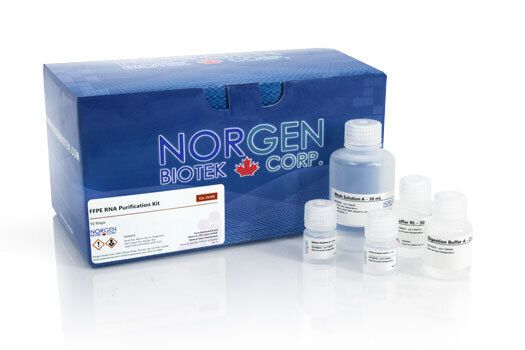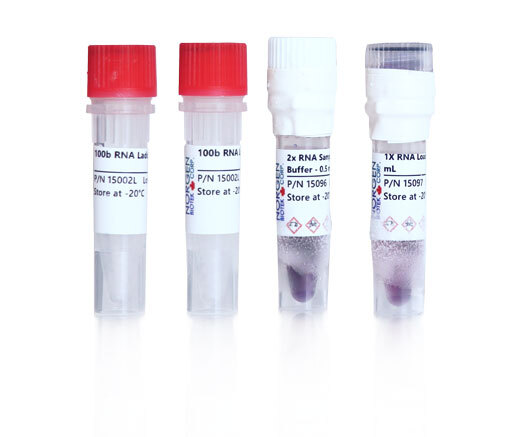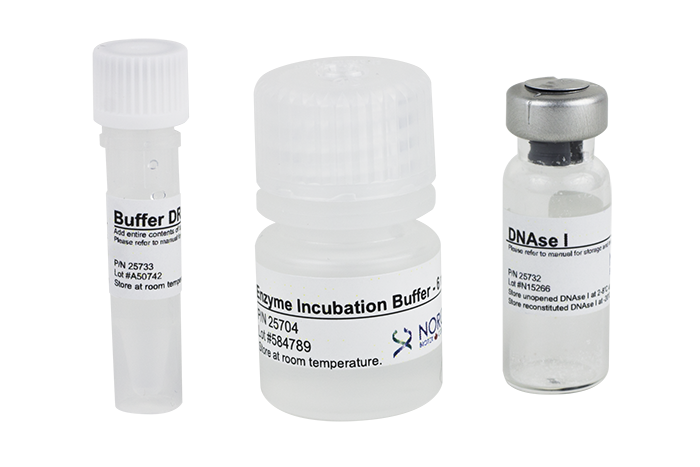FFPE RNA Purification Kits

For research use only and NOT intended for in vitro diagnostics.
CEIVDD marked diagnostic version available here
FFPE RNA Purification Kits
Register today to receive an exclusive 15% off* on your first order.
Supporting Data
Figure 1. High Quality and Yield of Total RNA. Norgen's FFPE RNA Purification Kit isolates FFPE RNA that exceeds both yield and quality of competitors. Total RNA was isolated from one slice of hamster FFPE kidney section (20 micron thickness) using Norgen's FFPE RNA Purification Kit and a leading competitor’s kit. One microliter of the 50 µL purified RNA was then resolved on an Agilent 2100 BioAnalzyer using an RNA Nano 6000 chip. As it can be seen, Norgen not only isolated higher yields of total RNA, but the RNA was also of a higher quality as evidenced by the higher RIN values obtained with Norgen's RNA.
Figure 2. Higher Yield of FFPE RNA Isolated by Norgen's FFPE RNA Purification Kit. Norgen's FFPE RNA Purification Kit isolates FFPE RNA that exceeds the yield of competitors. Total RNA was isolated from one slice of hamster FFPE kidney section (20 micron thickness) using Norgen's FFPE RNA Purification Kit and two leading competitor's kits. Eighteen isolations were performed for each product. The graph demonstrates the mean yield of RNA according to spectrophotometry for 18 sample replicates. Vertical bars represent the standard deviation. Norgen's kit consistently purified total RNA with a higher yield than for those obtained using the market competitor's kits.
Figure 3. High Yield of a Diversity of RNA Species. Norgen's FFPE RNA Purification Kit effectively recovers all sizes of RNA from large mRNA to small RNA including microRNAs. Total RNA was isolated from one slice of hamster FFPE kidney section (20 micron thickness) using Norgen's FFPE RNA Purification Kit and a leading competitor’s kit. Five microliters of the 50 µL purified RNA was then used as the template in a 20 µL reverse transcription reaction with oligo dT primer or miR-21 stem-loop reverse primer. Two microliters of the RT reaction was then used in a 15 µL qPCR reaction for detecting the beta-actin gene (Panel A) and for detecting miR-21(Panel B), respectively. In both graphs the blue lines correspond to Norgen isolated-RNA and the green lines correspond to competitor-isolated RNA. As it can be seen, Norgen's kit isolated higher yields of RNA in both cases, as indicated by the lower Ct values of the blue lines. Also, Norgen's kit successfully isolated not only large RNA (Panel A) but also microRNA (Panel B), indicating the diversity of RNA species isolated.
Figure 4. Excellent Performance in Downstream Application such as RT-qPCR. Norgen's FFPE RNA Purification Kit effectively recovers all sizes of RNA, from large mRNA to small RNA including microRNA, that perform effectively in sensitive applications such as RT-qPCR. Total RNA was isolated from equal amounts of an FFPE tissue sample using Norgen's FFPE RNA Purification Kit and two market competitors. The graph demonstrates the mean delta Ct value for 18 sample replicates. Vertical bars represent the standard deviation. Norgen's kit consistently isolates RNA of a higher yield and quality than that obtained by the two leading market competitors as indicated by the larger delta Ct values. Not only were the large RNA species detected including rRNA and mRNA, but small RNA species (microRNA) were also detected from the sample, indicating the diversity of RNA species isolated.
Figure 5. High Yield and Consistent Recovery of a Diversity of RNA Species. Norgen's FFPE RNA Purification 96-Well Kit effectively recovers all sizes of RNA including large mRNA to small RNA including microRNAs. Total RNA was isolated from two equal amounts of an FFPE tissue sample using Norgen’s FFPE RNA Purification Kit. The purified RNA was then used as the template in a RT-qPCR for detecting the beta-actin gene (Panel A) and for detecting miR-21 (Panel B). As it can be seen, Norgen's kit successfully and consistently isolated not only large RNA (Panel A) but also microRNA (Panel B), indicating the diversity of RNA species isolated.
|
Kit Specifications
|
|
| Maximum Column Binding Capacity |
Up to 50 µg RNA
|
| Maximum Loading Volume Per Spin Column |
650 µL
|
| Size of RNA Purified |
All sizes, including small RNA (< 200 nt)
|
| Time to Complete 10 Purifications |
1-4 hours*
|
| Maximum Amount of Starting Material |
5 slices of < 20 µm thick paraffin slices
25 mg of unsectioned block |
| Average Yield |
Variable due to age of paraffin blocks
~2-3 µg of Total RNA per 1 mg of fresh FFPE hamster kidney |
Storage Conditions and Product Stability
All solutions should be kept tightly sealed and stored at room temperature. The DNAse I and Proteinase K should be stored at -20°C upon arrival. This kit is stable for 1 year from the date of shipment.
| Component | Cat. 25300 (50 preps) | Cat. 25400 (2 x 96 preps) |
|---|---|---|
| Digestion Buffer A | 25 mL | 2 x 25 mL |
| Buffer RL | 30 mL | 2 x 30 mL |
| Enzyme Incubation Buffer | 6 mL | 2 x 6 mL |
| Wash Solution A | 38 mL | 2 x 38 mL |
| Elution Solution A | 6 mL | 2 x 20 mL |
| Proteinase K | 12 mg | 2 x 20 mg |
| DNase I | 1 vial | 2 x 500μL |
| Micro Spin Columns | 50 | - |
| 96-Well Incubation Plate | - | 2 |
| 96-Well Plate | - | 2 |
| Adhesive Tape | - | 8 |
| Collection Tubes | 50 | - |
| 96-Well Collection Plate | - | 2 |
| Elution Tubes (1.7 mL) | 50 | - |
| 96-Well Elution Plate | - | 2 |
| Product Insert | 1 | 1 |
Documentation
FAQs
Spin Column, High Throughput
Poor RNA recovery could be due to one or more of the following:
- Incomplete lysis of cells or tissue.
Ensure that the appropriate amount of Digestion Buffer A with Proteinase K was used. Increase the incubation time. - Column has become clogged.
Do not exceed the recommended amounts of starting materials. The amount of starting material may need to be decreased if the column shows clogging below the recommended levels. See FAQ related to “Clogged Columns/wells” below. - An alternative elution solution was used.
It is recommended that the Elution Solution A supplied with this kit be used for maximum RNA recovery. - Ethanol or Buffer RL was not added to the lysate.
Ensure that the appropriate amount of ethanol and Buffer RL are added to the lysate before binding to the column. - Ethanol was not added to the Wash Solution A.
Ensure that 90 mL of 96 - 100% ethanol is added to the supplied Wash Solution A prior to use. - Low RNA content in cells or tissues used.
Different tissues and cells have different RNA contents, and thus the expected yield of RNA will vary greatly from these different sources. Please check literature to determine the expected RNA content of your starting material.
Clogged columns/wells can result from one or a combination of the following factors:
- Insufficient solubilization of cells or tissues.
Ensure that the appropriate amount of Digestion Buffer A was used for the amount of cells or tissue. - Maximum number of cells or amount of tissue exceeds kit specifications.
Refer to specifications to determine if the amount of starting material falls within kit specifications. - Clarified lysate was not used for the binding step.
Ensure that after the lysis step the sample is centrifuged if a significant amount of debris is present, and that only the clarified lysate is used in subsequent steps. - Centrifuge temperature is too low.
Ensure that the centrifuge remains at room temperature throughout the procedure. Temperatures below 15°C may cause precipitates to form that can cause the columns to clog.
RNA can be degraded due to the following factors:
- FFPE sample is old.
The quality of RNA purified may drastically decrease in old samples. For best performance, freshly prepared samples are highly recommended. - RNase contamination.
RNases may be introduced during the use of the kit. Ensure proper procedures are followed when working with RNA. Please refer to “Working with RNA” at the beginning of this user guide. - Procedure not performed quickly enough.
In order to maintain the integrity of the RNA, it is important that the procedure be performed quickly. This is especially important for the Cell Lysate Preparation Step in the Animal Tissue protocol, since the RNA in animal tissues is not protected after harvesting until it is disrupted and homogenized. - Improper storage of the purified RNA.
For short term storage, RNA samples may be stored at –20°C for a few days. It is recommended that samples be stored at –70°C for longer term storage. - Prolonged incubation at 80°C.
In order to reverse formalin cross-links, an incubation at 80°C is required. Do not exceed 15 minutes of incubation at 80°C as this will increase RNA fragmentation. - Starting material may have a high RNase content.
For starting materials with high RNase content, it is recommended that β-mercaptoethanol be added to the Buffer RL.
If the RNA does not perform well in downstream applications, it may be due to one or more of the following:
- RNA was not washed 3 times with the provided Wash Solution A.
Traces of salt from the binding step may remain in the sample if the well is not washed 3 times with Wash Solution A. Salt may interfere with downstream applications, and thus must be washed from the well. - Ethanol carryover.
Ensure that the dry spin under the Well Wash procedure is performed, in order to remove traces of ethanol prior to elution. Ethanol is known to interfere with many downstream applications. - Formalin crosslink was not completely reversed.
Ensure sufficient incubation at 80°C is performed in Step 2b in the protocol. Do not exceed 15 minutes of incubation at 80°C as this will increase RNA fragmentation.



